Quince preserves are amongst the most favorite spoon sweets in Greece. If it's the first time you hear of spoon sweets then let me tell you what they are.
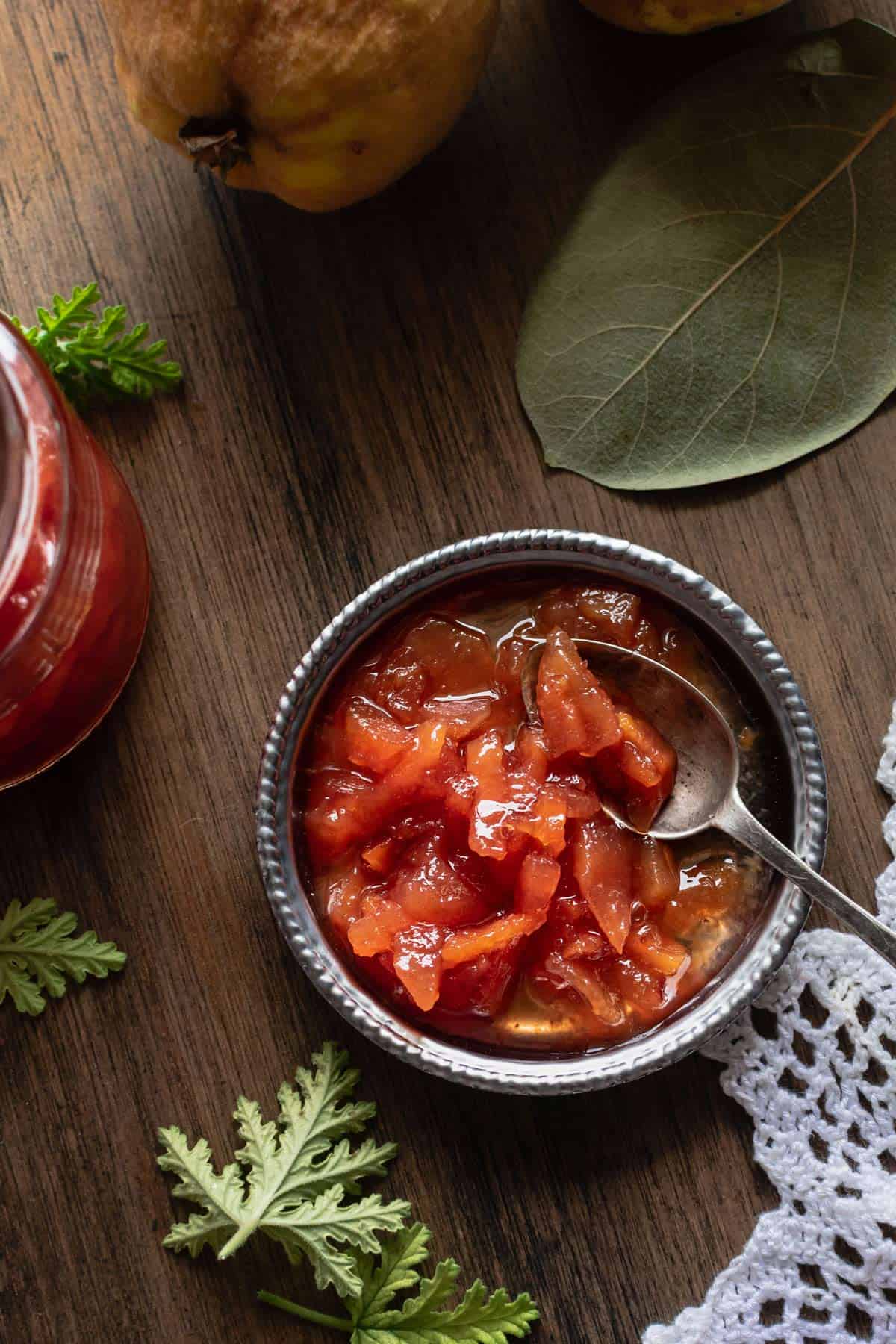
Greek spoon sweets are fruits preserved in syrup. They are called spoon sweets because traditionally, they are served in the amount of a tablespoon. It's an old-fashioned sweet delicacy that used to be in every Greek home to treat each guest that came to visit. Along with a cup of Greek coffee (or Turkish it's the same thing). They were so much in fashion the past decades for many reasons.
A few of these are: they are budget-friendly, it's an easy way to preserve almost every fruit (sometimes even vegetables like melitzanaki) that is in season. Also, they keep nicely, stored in a dark cupboard for up to a year (as there is no need to refrigerate them). Serving a spoon sweet to a guest back in the '50s or '60s was a way for women to show how good and hospitable housewives they were. If you didn't have a treat for the guest, that was really not too complimentary for you (that is, if you are a woman reading my post 😁).
So, as you can imagine, there are spoon sweet recipes for almost every fruit and every season. But the top 3 Greek Spoon Sweets (90% of Greeks will agree to this) are sour cherry (or vissino in Greek), quince, and grapes. Sour cherry spoon sweet is one of the most laboring to make. As you have to remove the pits with a special tool one by one. So not many people make it at home nowadays. Though it is used widely in many Greek dessert recipes (like this must-try Ekmek). On the other hand, grape and quince spoon sweets are much easier to make. I'm not saying that making spoon sweets is easy and effortless. But I think they do worth the effort when you get to keep your favorite fruit all year round and enjoy it in so many ways such as...
How To Eat A Spoon Sweet...
- Serve on top of Greek yogurt or ice cream.
- Serve as a topping to a cake.
- Use it to make a fruit tart.
- Use the syrup along with soda or sparkling water as a homemade fruit beverage.
- Serve with pancakes and crepes.
- Or serve as is, along with your afternoon coffee.
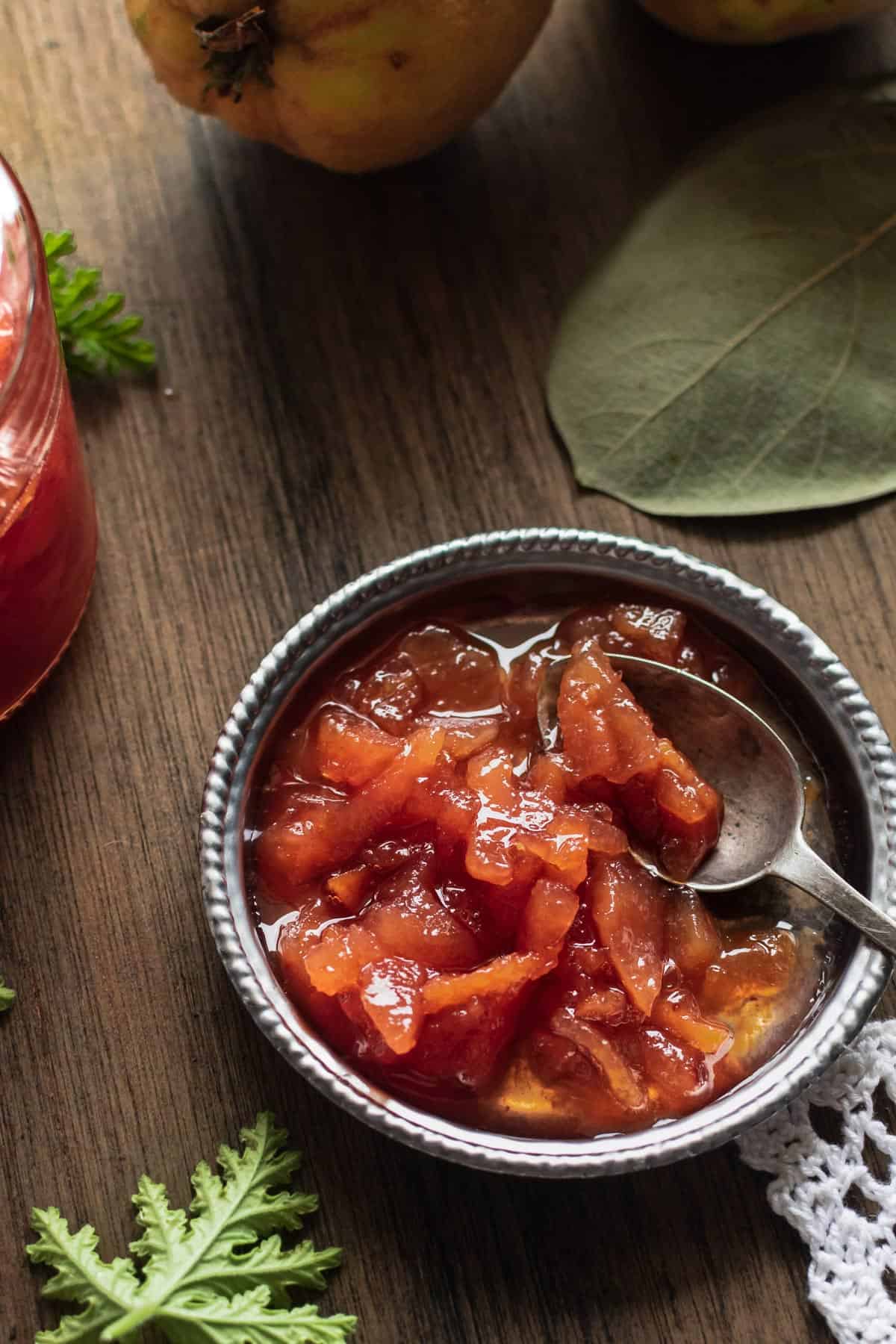
How To Make The Quince Preserves (Spoon Sweet)
Quince preserves are made in three simple steps:
- Peel and core the fruit. Then cut the flesh into very small strips.
- Steam cook the fruit in your stovepot until completely soft.
- Add the sugar and a bit of water and cook until a thick, glazy syrup forms. Ready to store!
A few things you need to keep in mind though, regarding each step. For step 1, keep in mind that Quince is a hard fruit and you will need a sharp cutting peeler and knife to save you both time and effort. Also, because of that, the strips won't look too even in shape. That's why some prefer to cut the quinces with a box grater as mentioned in the recipe below.
About step 2, when I say steam cooking I don't mean a pressure cooker. All you need, is a classic cooking pot with a lid. Add the prepared fruit, a bit of water, and simmer with the lid on, until the fruit gets really soft and tender. The lid on the pot helps create the desired steam for the quinces to soften to perfection. After many times of making this spoon sweet, I found out that this little thing makes a whole difference in properly softening the fruit.
As for step 3, there is no exact time of how long you should simmer the fruit with the sugar. An approximate amount of time is 30 to 40 minutes. The more you cook it, the deeper the color, and the sweeter it will get. So what you have to do to get the best results, is to keep an eye on and stir with a wooden spoon every now and then. Then when you think it's ready, take a teaspoon and add a spoonful of the sweet on a plate. Let it stand for 3-4 minutes until it has cooled down to room temperature. And then you'll be able to tell if it's ready or not.
The syrup shouldn't be runny like water as it cools down but nice and thickened. Not to the point, it feels sticky on the plate though. If this happens no worries, it is just syrup, add a little bit of water to the pot, and simmer a few minutes more.
It does not matter if you have made the same spoon sweet a million times before. Testing the sweet on a little plate is the only way to tell if it's done or not! Even my grandmother who has been making spoon sweets all of her life never takes the pot off the heat before she tests the sweet that way first.
Flavorings You May Add
The traditional Greek flavoring for this spoon sweet, as well as for many others, is a few leaves of lemon geranium. This gorgeously scented plant gives a really unique flavor to spoon sweets and also enhances their color giving them a deeper red. If you cannot find it, it's okay, a stick of cinnamon will do. In addition to the cinnamon stick, you may add a lemon peel to create a more complex flavor. Plus, it makes up for the missing lemon scent of the lemon geranium.
Another extra flavor you can add to this delicious quince sweet is the addition of toasted almonds. Many Greek women make it this way. They mix the almonds right in the pot when the sweet is ready to be stored in jars. If you wish to do it that way yourself, use about a handful of raw skinned almonds that you have lightly toasted in your oven first.
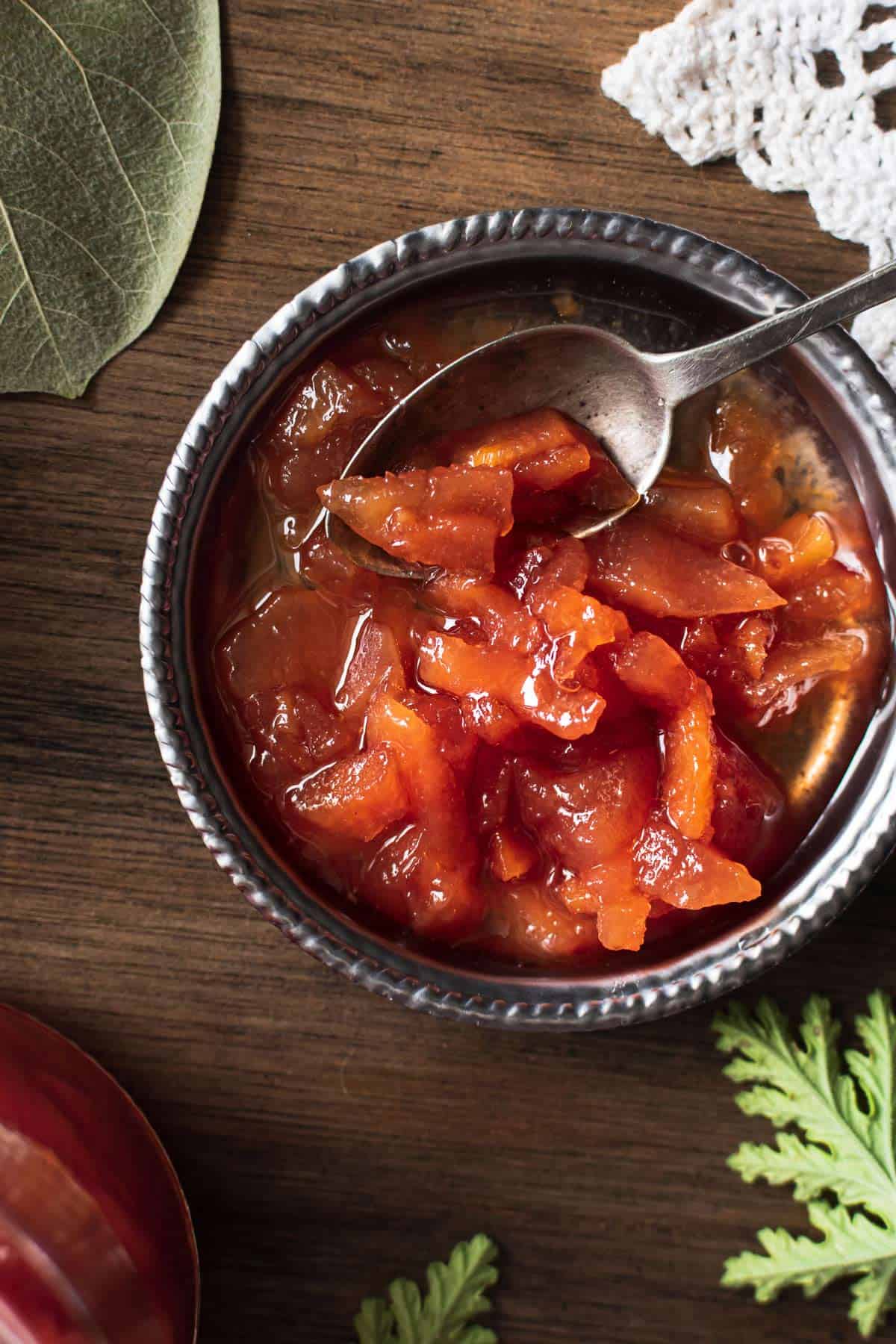
Canning And Storing
You will need 2 canning jars of 500 ml each. Or you can use 4 jars of 250 ml if you wish to give this quince spoon sweet as a gift to friends. Either way, you need to sterilize the jars first, by washing them well, with soap and water. Preheat your oven at 160°C /320°F. Lay a clean tea towel in a baking pan, and place the jars upside down in the pan. Don't forget to add the lids next to the jars to sterilize as well. Then place the pan in the oven for 15 minutes.
Transfer the spoon sweet to the jars while it is still very hot (this helps the lid to airlock better). If the spoon sweet has cooled down, simply heat it up again for just a minute. Make sure you leave ¼ of an inch (½ cm) breathing space when adding the sweet to the jars. So the sweet doesn't reach all the way up and touch the lid.
Finally, once the jars are filled with the sweet and closed with their lids, turn them upside down and let them sit this way until they have cooled down to room temperature. This ensures the lid closes tightly.
This canning method is advisable just for spoon sweets, marmalades, and jams. Due to the large amount of sugar they contain which helps in their safe preservation.
Spoon sweets can either be stored in a dark cupboard or in the fridge for up to a year. This really depends on whether you like the flavor of the sweet cold or at room temperature. When a syrup is at room temperature it tends to feel overwhelmingly sweet sometimes. And that's the reason you may prefer spoon sweets served cold from the fridge.
Recipe
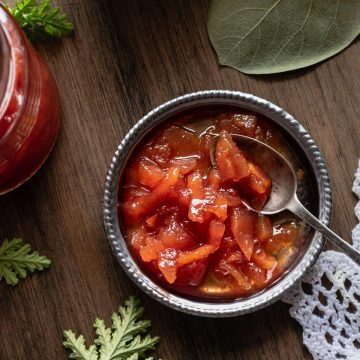
Quince Preserves - Greek Spoon Sweet
Equipment
- 2 500 ml canning jars
Ingredients
- 970 grams (about 34.2 oz) quinces peeled and cut see instructions below
- 1 kilogram / 35.2 oz sugar
- 1 teaspoon fresh lemon juice
- OPTIONAL: 2-3 leaves of lemon geranium (or 1 cinnamon stick and a lemon peel instead)
Instructions
Sterilize The Jars:
- Wash them well with soap and water. Without letting them dry, place them on a pan that you have covered with a clean tea towel. Then place the pan in a preheated 160°C /320°F oven for 15 minutes.
Prepare Quinces:
- Quince is a hard fruit so you will need a really sharp peeler and knife to cut it.
- Remove the skin of the quinces using a vegetable peeler. Cut them in half, and then each piece in half again. Cut and discard the center containing the seeds.
- There are two ways to cut quince for making a spoon sweet. One is to cut it with a knife into small strips of about ¾ of an inch long and ⅓ of an inch thick (1 ½cm long and ½ cm thick). Some pieces won't look much like strips but that's okay. And the other way which is widely used around Greece is to cut it with a box grater using the larger grating holes. You can use whatever way is easier for you. The results will be more or less the same. Using the knife method, you will get chunkier uneven pieces while using the box grater will give a smoother even texture to the final result. The softness or crispness of the fruit will depend more on the cooking time and not so much on the size the fruit is cut.
Make The Spoon-Sweet:
- Add the quince pieces to a large cooking pot. It's okay if they have gotten dark in color by the time you finished preparing them. Cooking them will fix this.
- Add 150 ml of water to the pot as well. Bring to a boil over high heat. Then reduce heat to medium-low and put the lid on the pot. Let simmer this way until the fruit has gotten completely soft. It takes approximately 45 minutes, but this will depend also on how ripe the quinces are, and how strong the heat of your kitchen stove is. So keep an eye on, especially towards the last minutes of cooking to make sure there is enough moisture within the pot so the fruit won't stick at the bottom. If needed, add a splash more water.Note: To properly tenderize quince you need to let it steam cook that's why it is cooked completely covered and with just enough water in the pot to create the desired moisture.
- Once the fruit is cooked and softened, add the sugar to the pot, along with 300 ml of water, the lemon juice, and the lemon geranium leaves if you are using them (see post above for alternative flavorings).
- Simmer over medium heat partly covered for about 30 to 40 minutes. Until the syrup looks nice and thick. To check if the syrup is at the right consistency, take a little plate and add a spoonful of the spoon-sweet to it. Within minutes, it will cool down to room temperature and you'll be able to see how thick the syrup is. It shouldn't be too runny just nice and thick. The texture of a spoon-sweet is a tad runnier than that of a jam and the syrup should be just enough to cover the fruit.
- Transfer the preserves to the sterilized jars while it's still hot, leaving ¼ of an inch (½ cm) space from the lid. Then flip the jars upside down to airlock and let them cool down like this at room temperature. Store in a dark cupboard for up to 1 year or in the fridge. Note that the fruit tends to get harder when refrigerated.
Nutrition
YOU MAY ALSO LIKE...

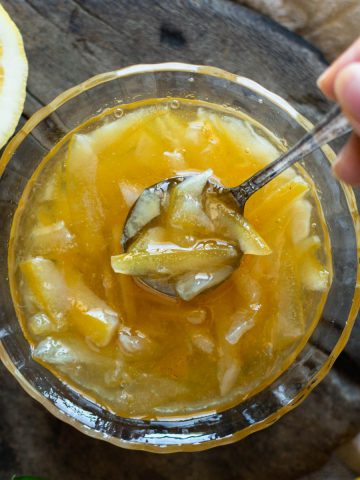
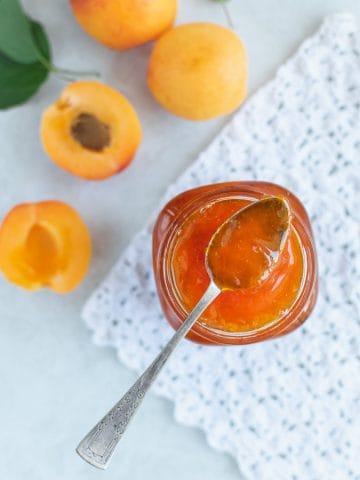
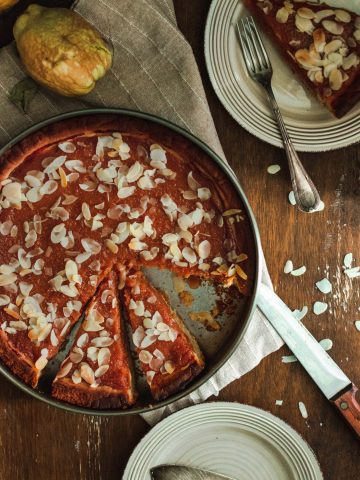
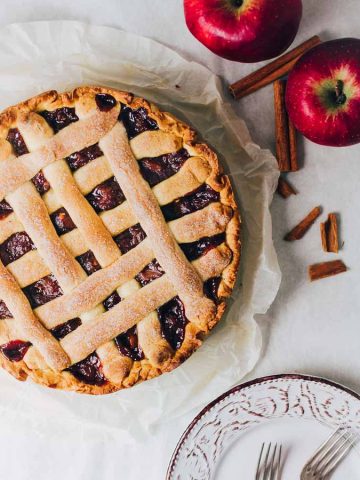
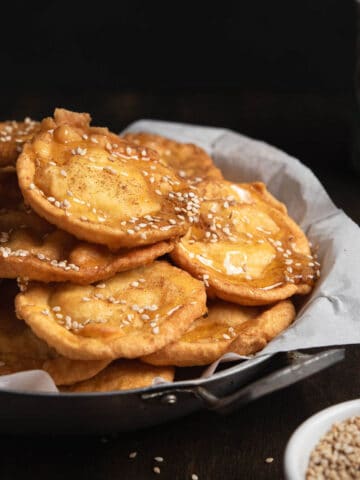
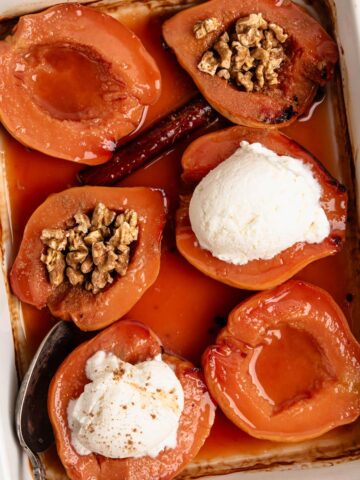
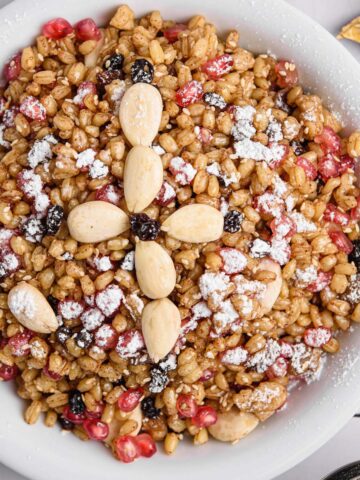
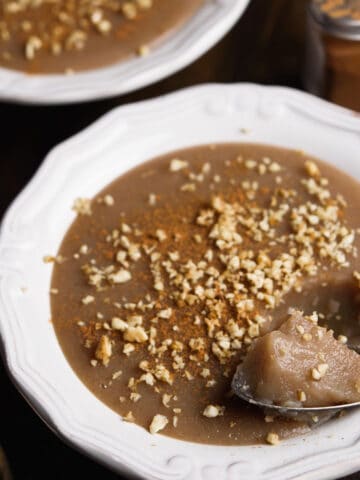
Leave a Reply